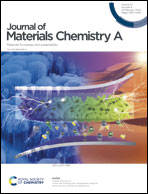Thermoelectric properties of organic charge transfer salts from first-principles investigations: role of molecular packing and triiodide anions†
Abstract
The potency of charge transfer (CT) salts in thermoelectric (TE) applications based on (5-CNB-EDT-TTF)4I3 is systematically explored by first-principles calculations combined with Boltzmann transport theory and deformation potential theory, focusing on the effects of molecular arrangements and triiodide anions. It is found that the linear orientation of triiodide anions and parallel donor stacks with face-to-face mode endow the β′′-phase CT salt with a small bandgap and a sharp but delocalized DOS near the Fermi level. Consequently, the β′′-phase exhibits a simultaneously increased Seebeck coefficient and excellent electrical conductivity. Meanwhile, the unique electronic band structure helps the β′′-phase exhibit novel temperature dependence of the Seebeck coefficient, which contributes to an excellent power factor value over a wide temperature range. In addition, the triiodide anions can substantially reduce the effective mass of CT salts and thus enable intrinsically superior power factors. Our work reveals the remarkable potential of CT salts as high-performance TE materials and elucidates the mechanism behind how molecular packing regulates constraints between TE parameters.



 Please wait while we load your content...
Please wait while we load your content...